Solvency Ratio Formula
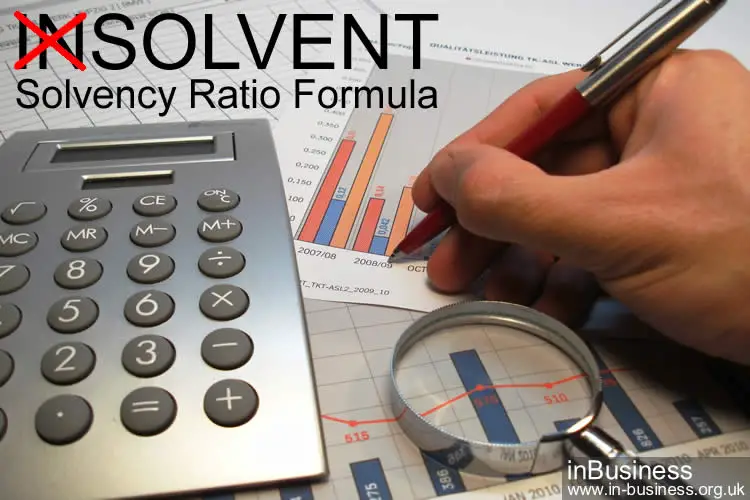
This article is about the ‘solvency ratio formula‘ and is written by Russell Bowyer. This subject is one that I’ve had experience within my own company and in helping other entrepreneurs in business.
The following headings are discussed in this article:
- What is the Definition of the Solvency Ratio Formula?
- Solvency Problems are Stressful for Company Directors.
- So What is the Solvency Ratio Formula? Includes an example of using the formula.
- What is Considered to be a Good Solvency Ratio?
- 20% is a Guide Only. Other Factors That Affect Company Solvency.
- There are Additional Solvency Ratios to Keep Track of.
- Interest Cover Ratio.
- Liquidity Ratios: Including Current Ratio & Quick Ratio
- Introducing the 5 Pillars of Solvency.
- Solvency Ratio Formula Info-graphic.
What is the Definition of the Solvency Ratio Formula?

According to Investopedia it is “A key metric to measure an enterprises ability to meet its debt and other obligations.” I would add to that definition by saying it is also important to meeting debt and other obligations…’as and when they fall due.’
The solvency ratio is a good indicator as to whether a company will have sufficient cash flow. Cash flow required in order to meet its current and long-term liabilities.
If a business is unable to meet its liabilities, as and when they fall due, then it’s deemed to be insolvent. An insolvent company may need to take steps to either remedy the situation or consider alternatives, like ceasing to trade.
Solvency Problems are Stressful for Company Directors

When a company is going through solvency issues this can be extremely stressful for the directors.
Directors must be aware of fraudulent or insolvent trading at all times. They must be careful not to take on debt with the knowledge that it’s not going to be paid.
An insolvent company may have to appoint either a receiver and go into administration or a liquidator and go into liquidation.
So keeping a close eye on the companies solvency ratio is key for management. Along with other important key performance indicators. The key is to have up-to-date management information, in order to assess the various ratios and indicators in a timely fashion.
The art of great management is all about planning. By having current up-to-date records will give an early heads-up of any problems forming. This will enable management to plan ahead and make good decisions.
In addition to the solvency ratio formula, there are other forms of solvency ratio to guide a company’s management team.
So What is the Solvency Ratio Formula?
Solvency Ratio = (Post Tax Profits + Depreciation & Amortisation)/ Total liabilities*
* Total liabilities = Both short-term liabilities (i.e. falling due within one year) and long-term liabilities (i.e. falling due after more than one year)
This Solvency Ratio Formula is Best Explained by Way of Example:
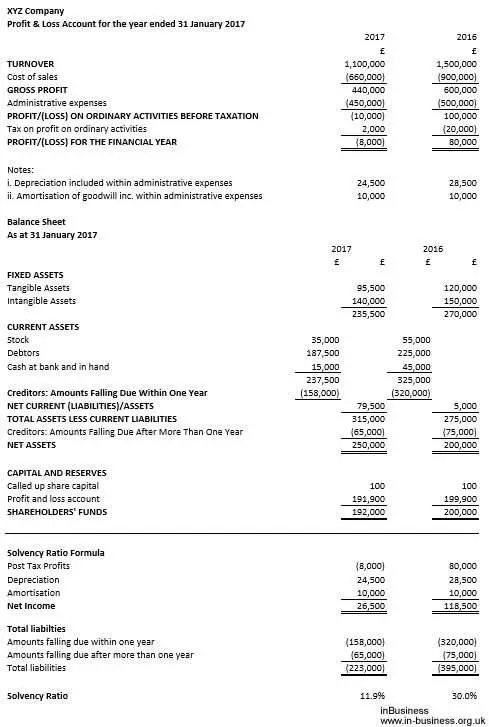
In the above example balance sheet the solvency ratio for XYZ Company is 30%. Whereas in 2017 this has dropped to 11.9%. These two solvency ratios are calculated, as follows:
2016 year: £118,500/£395,000 = 30%
2017 year: £26,500/£223,000 = 11.9%
What is Considered to be a Good Solvency Ratio?
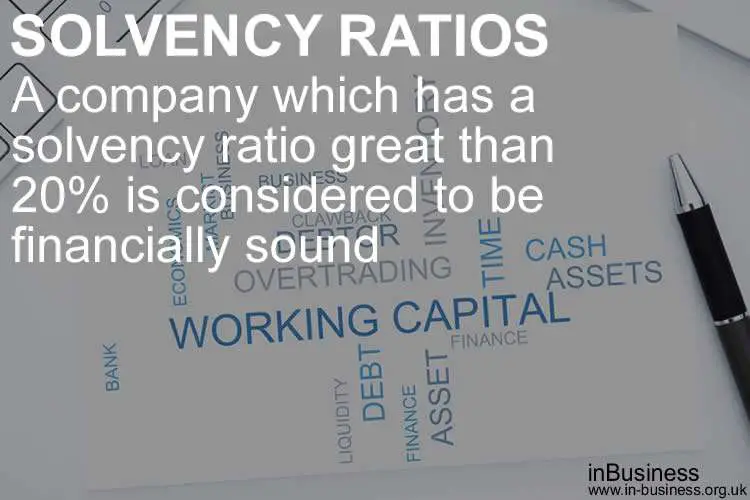
A company which has a solvency ratio great than 20% is considered to be financially sound. In 2016 XYZ Company is healthy with a solvency ratio of 30%. However, as the solvency ratio has dropped to 11.9% in 2017, this company’s solvency is below what is considered to be safe.
Solvency Ratio Formula: The lower the solvency ratio the higher the probability of a company defaulting on its debt. 20% or above for a company’s solvency ratio is a good guide for a financially sound company.
We can already see that the turnover has dropped for XYZ Company and the business has made a loss. So the directors would need to be reviewing their solvency ratio. They will also need to be carefully monitoring cash flow. Assuming that they have good accounting records, they should already have a plan to resolve the down-turn in business.
20% is a Guide Only. Other Factors That Affect Company Solvency
Whilst a metric like the solvency ratio formula is good as a guide, there are many other factors to consider. For example, included within this calculation is company debtors (including accounts receivable). The solvency formula adjusts for ‘Non-cash’ expenses like depreciation and amortisation, but as we all know profit is not always cash in the bank.
Where the business is inefficient at the collection of its debtors, the solvency ratio may look good, when in fact cash flow is being badly affected by slow paying customers.
Companies must convert profits into cash. An example of where this becomes a serious problem is in one of the ten deadly mistake made by many entrepreneurs, which is over-trading.
This is why management shouldn’t use the solvency ratio formula in isolation…
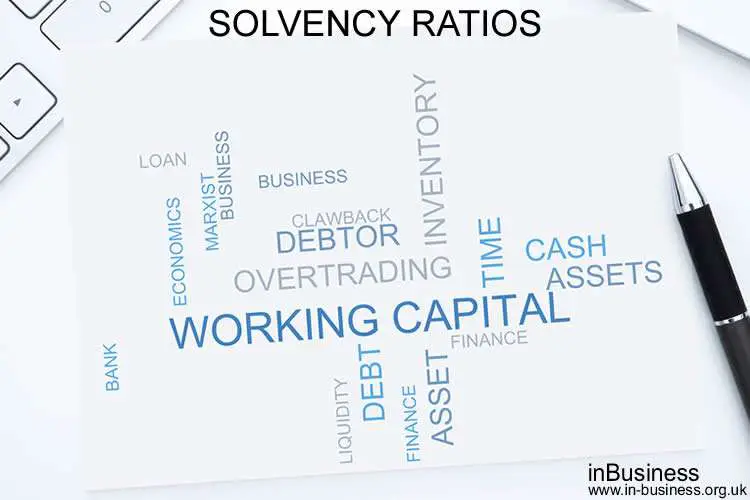
In Addition to the Solvency Ratio Formula; There are Additional Solvency Ratios to Keep Track of:
1. Interest Cover Ratio

The interest cover ratio is a company’s operating income (i.e. profits before interest and tax; EBIT) divided by the interest expense. So for example if a company has made a profit before interest and tax of £60,000 and interest on the loan is £30,000 the interest coverage ratio is 2.
An acceptable interest cover ratio is 2 or more. Banks prefer a coverage of 3 though. However, if the cover drops to 1 or below, this indicates a company which cannot meet its interest obligations as they fall due.
Bank borrowing usually comes with interest cover terms. Loan agreements usually include covenants. One of which is usually profitability and interest cover. Where the interest cover ratio falls below what’s in the covenant, the bank can call in the loan.
Solvency Ratio Formula: This is just one of the many ratios a company should keep a track of. This is especially true when times get tough.
2. Liquidity Ratios

There are a number of liquidity ratios which are good to use alongside the solvency ratio formula. These include the following:
Current Ratio – This is the ratio between current assets and current liabilities
The formula to work this out is: Current Ratio = Current Assets/Current Liabilities. In the example above of XYZ Company the current ratios are 11.5 for 2017 (i.e. £237,000/£158,000); and 1.01 for 2016 (i.e. £325,000/£320,000). Interestingly enough in this example, the current ratio has improved.
The lower the current ratio, the less current assets a company has to cover its current liability obligations. Anything below 1 indicates a company which is not in good financial health.
The current ratio is still dependent on the company’s ability to collect its accounts receivable on a timely basis. For example, you could have a company with a high current ratio, when in fact its trade debtors are high and are not being collected.
Quick Ratio – this is similar to the current ratio, but includes current assets that are easily liquid assets
The formula to work out the quick ratio = (Current Assets – Stock)/Current Liabilities. Which for XYZ Company equates to 1.28 for 2017 (i.e. (£237,500-35,000)/158,000); and 0.84 for 2016 (i.e. (£325,000-£55,000)/£320,000). Ideally for a healthy company the quick ratio should also be over 1.
The quick ratio, or acid-test ratio, is not fool-proof. As before, if the business is not collecting its accounts receivable on time, the quick ratio will not work.
The solution to having a healthy solvency ratio is to have a good cash flow from a profitable business. Get prompt payments from your customers and keep your stock levels to a minimum.
Introducing the 5 Pillars of Solvency
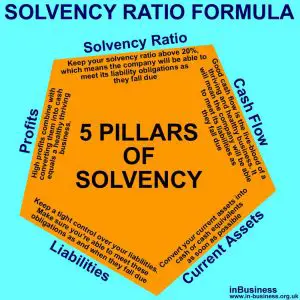
Having thought about the solvency question for businesses and just written about the Solvency Ratio Formula, I came up with the 5 Pillars of Solvency. So what are the 5 Pillars of Solvency?
1. Solvency Ratio Formula
Keep your solvency ratio above 20%, which means the company will be able to meet its liability obligations as they fall due.
2. Cash Flow
Good cash flow is the live-blood of a thriving and healthy business. It will mean the company will be able to meet its liabilities as they fall due.
3. Current Assets
Convert your current assets into cash or cash equivalent as soon as possible.
4. Liabilities
Keep a tight control over your liabilities. Make sure you’re able to meet these obligations as and when they fall due.
5. Profits
High profits combine with converting them into cash equals a healthy thriving business.
Solvency Ratio Formula Info-graphic
The above 5 Pillars of Solvency for keeping a healthy solvency ratio are represented in an Info-Graphic below:
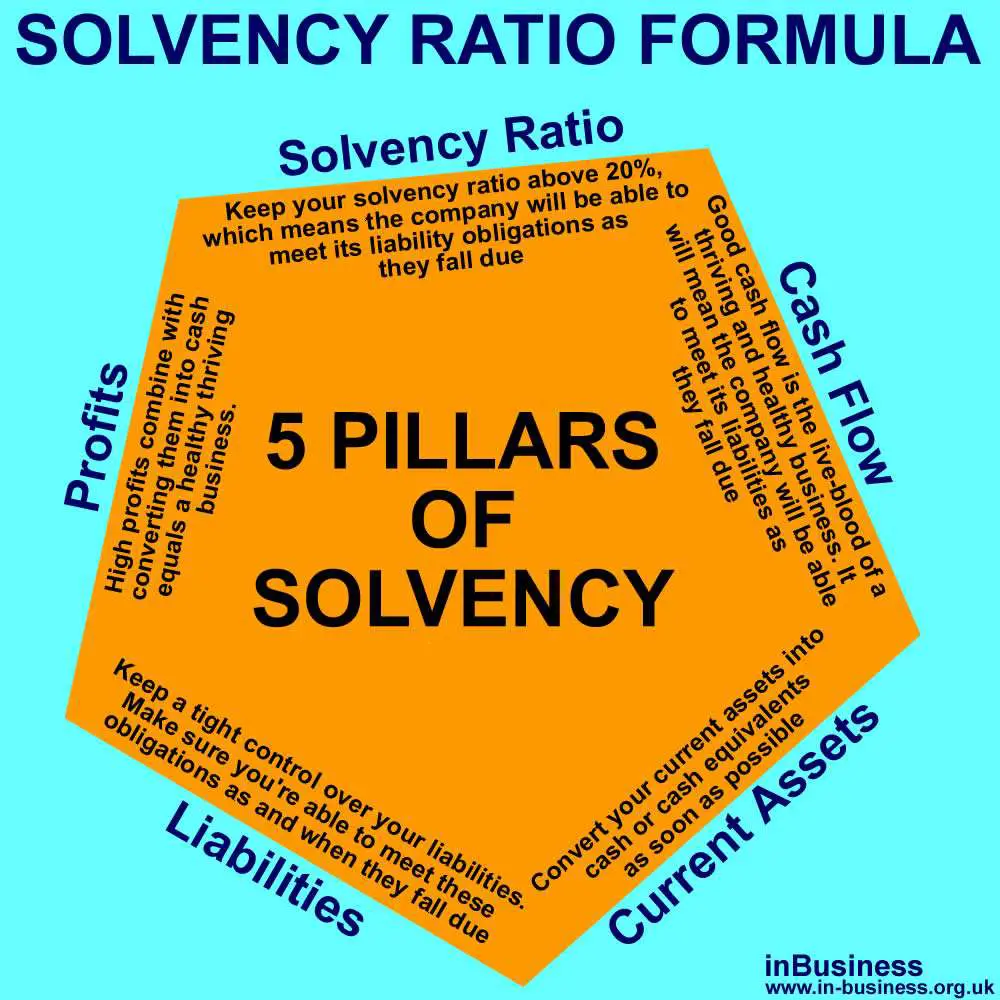
And finally…
If you enjoyed reading this article on Solvency Ratio Formula, please share it on your favourite social media channel below. Thank you for reading inBusiness Blog.
Also, if you’d like to discuss the company and business solvency issues on our business forum you can do this here – Business Forum Discussions.
If you would like to see this article in PowerPoint (ppt) style, see below:
[slideshare id=76188122&doc=solvencyratioformula-170521203244]
Not sure how I did not see this before. Thanks for the very good material.